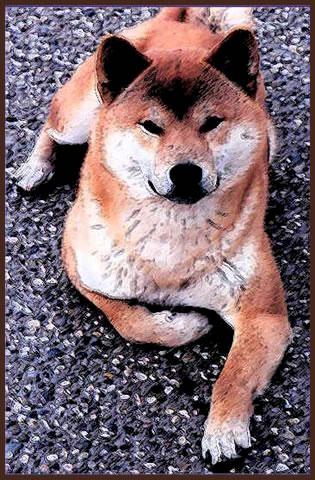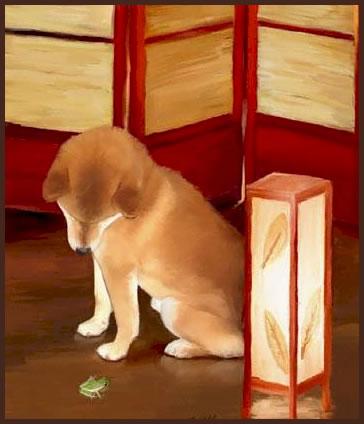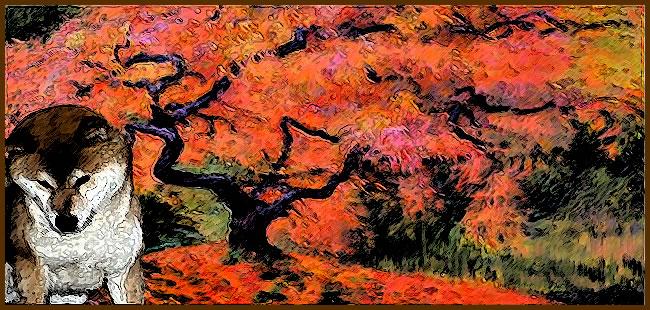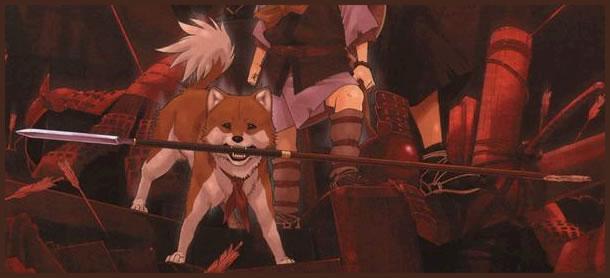 |
|
|---|
 |
Japan was originally inhabited around 7,000 or 8,000 BC. The group of people named the Jomonjin (Rope-Pattern People – from pattern found on their earthenware) migrated from three different parts of Asia. Japan is made up of four primary islands and 75 percent of the land is mountainous. Archeologists have discovered that these people had small dogs ranging from 14 to 20 inches in height. These are believed to be ancestors of today’s Shiba. The skull type of the dogs found is very different from other dogs found in Europe in the same time period. Most agree that these small dogs came from Mainland China. |
Later, during the third century BC another group of immigrants brought dogs, which interbred, with the dogs of the Jamonjin. The offspring had curly tails and erect ears.
The earliest recorded history in Japan began in the sixth century AD. The imperial court created a ‘dog keepers office’. This led to dogs becoming an important part of Japanese culture. Over the next few hundred year’s military pursuits led to a samurai class leadership. During this period very few foreigners were allowed to enter the country. Hunting (birds, boar and deer) became a very popular activity for these people. Under the rule of the fifth Shogun (Tsunayoshi), dogs actually had more rights than humans.
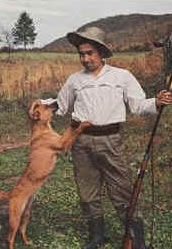 |
During the eighteenth century, many other breeds of dogs were imported for hunting and companion purposes. These dogs lived mainly in the towns and cities and interbred with other dogs in those areas. Native dogs in the country remained pure. A Dutch doctor who visited Japan in the early 1800’s recorded two types of dogs living in Japan. In the city, a droopy eared canine and in the country, a hunting dog with pointed ears. By the early twentieth century, conditions in Japan had changed so much that the Japanese native dog had disappeared from all but the most isolated parts of the country. Some Japanese realized that the country's heritage was in danger and moved to preserve the culture, including the dogs. At the time, the breeds of the area did not have true names. They were called inu (dog), Ji-inu (native dog), inoshishi inu (wild boar dog), or shika inu (deer dog). The dogs in each area were unique (size and color). Dr. Hiroyoshi Saito named the main types of dogs after the areas of Japan in which they lived. The Shiba however does not refer to any geographical region of Japan. The name Shiba Inu loosely translated means little brushwood dog. |
Today’s Shiba Inu descended from two old Japanese breeds. One, the Mikawa who was also a small Spitz type breed. This breed was restless, timid, with round eyes, no white shading on cheeks or underbody and was faulted for a black mask. The Malawa was also known as the ‘Sanshu’. This breed was never considered a pure example of a Japanese native dog and is no longer popular. The breed can no longer be registered in Japan. The early Shibas were divided into three groups. The Shinshu, Mino, and Givu Prefecture. Each came from a different part of Japan. All three were called Shiba. The Shinshu was small and mainly red in color. It had round eyes and a black mask. The Mino had a fiery red coat, triangular eyes and thick ears with a sickle tail. The Sanin was a bit larger, mostly black and had a feisty independent temperament.
In 1928, Dr. Saito founded a club to preserve the native dog of Japan. Three founders who were credited for preserving the Shiba were Tatsuo Nakajo, Masayu Ishikawa, and Masuzo Ozaki. These men researched and catalogued the few remaining pure Shibas. In 1932 the club was named ‘Nihon Ken Hozonkai’, which means ‘Association for Preservation of the Japanese Dog’. This organization is known as Nippo. The first native dog to become a Natural Monument was the Akita in 1931, followed by the Shiba in 1936. After establishing standards for the six Japanese breeds (listed with photo below), they held their first show on November 6, 1932. Of the fifteen Shibas entered only ‘Tao’ rated suit ken (recommended dog). In 1939, a 10-month-old male named ‘Aka’ won a major Merit Award (similar to group placing here). His bloodline survived W.W.II and became the foundation for the modern Shiba Inu. In 1942, World War II put an end to dog-related activities. During the war, dog owners were asked to give up their dogs to supply rations to the military. Immediately after the war, distemper ravaged the country further depleting the Shiba Inu population. The Mino and Sanin Shibas were wiped out completely. The Shinshu survived. In 1948 dog showing resumed and a Shiba Inu named Naka won the highest honors.
Today the Shiba Inu enjoys the status as the most popular small dog in Japan.
Shibas arrived in the U.S. in 1954, brought by an armed services family. It was not until the late 70’s that Americans began importing Shibas. The Shiba Inu's popularity has grown tremendously ever since.
The following six Spitz Breeds along with the Shiba make up the Japanese Spitz Group of dogs:
 |
Akita: Originally Akita’s were developed for fighting. This breed is centuries old. Later the Akita was used for hunting boar, deer and bear. The Akita is a very good watchdog and loyal companion. Height: 24-28 in. Weight 75-100 lbs.Ch. Yuko's Tomoko from Yuko Kennels, Monroe, NY |
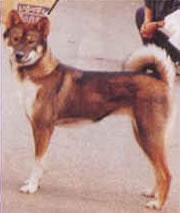 |
Sanshu: This breed comes in two sizes. Small to Large (16-18 in.) and (20-22 in.) The larger more closely resembles an Akita while the smaller looks more like a Shiba. The Sanshu comes in a variety of colors including white or cream. This color is frowned upon in the Shiba but acceptable in the Sanshu. Neither size of the breed has received official recognition. |
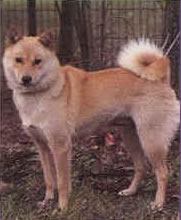 |
Ainu: A very old breed introduced to Japan over 3,000 years ago. This breed stands 18-21 in. They are used as a working dog and are extremely brave. The Ainu will hunt large animals like bear. He has a more primitive temperament than the other Spitz breeds in this group. |
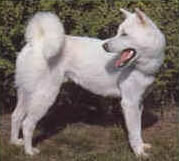 |
Kishu: Also, a hunting dog but has also been used for herding and guarding. Usually the coat is white so that the dog is very visible from the prey he is hunting. The height is 17-22 in. Milder tempered than the Ainu. |
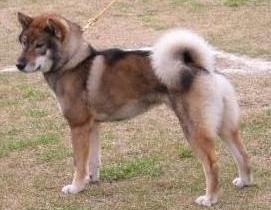 |
Shikoku: Stands 17-22 in. Also known as a ‘deerhound’ because they used to hunt deer. There are only two acceptable colors, red and brindle. |
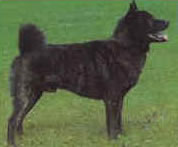 |
Kai: Stands 18-22 in. Extremely loyal to his master, considered by some to be a ‘one person’ dog. They were used to hunt deer and boar. They are always brindled in color although it may take 6 months to appear. The Kai has been introduced to the U.S. in 1990. |
| In Japan, the Shiba Inu is the most popular dog with more than 1 million registered. Shibas are extremely intelligent, active small dogs. Sometimes they are described as a ‘large dog’ in a ‘small dogs’ body. The Shiba believes that it can take on the world no matter how big the task. Shiba Inus have a typical spitz like personality with a little terrier and cat habits added. They are very loyal, energetic, stubborn, clean, athletic and brave. | 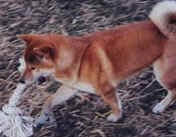 |
Shiba Inus have a life span of between 12-15 years normally. Some have been known to live longer. Sometimes slightly aloof at the first introduction, they never forget a good friend. They are very loyal to their owners. A Shiba puppy must establish trust with humans at a very young age, as it is much more difficult to socialize an adult. Puppies should have extensive human contact at a very young age (3-8 weeks is most important). To gain the trust of an adult unsocialized Shiba may take up to a year. Our Shibas do have unique personalities. One is quite cautious and has an almost intuitive nature. Another is extremely outgoing and always looking for ‘cookies’. All Shibas do love to play, and run fast.
The Shiba Inu is a primitive “original’ dog who has retained many ancient characteristics. The Japanese use three words to describe the Shiba temperament “Kan-i” which means bravery and boldness combined with composure and mental strength. The opposite is “ryosei” which means good nature with a gentle disposition. One trait cannot exist without the other. Shibas respond well to positive reinforcement and verbal commands. By being firm and consistent, a Shiba will learn to respect your wishes. A Shiba will lose all respect for his owner if they are physically punished. Shibas are a very proud intelligent breed and do not like being teased or embarrassed. Shibas have very strong wills and very easily learn tricks etc. although sometimes they choose not to perform.
Originally the Shiba Inu was bred to hunt small game. For this reason, the Shiba cannot be trusted ‘off-leash’. When chasing something they tend to forget their master exists no matter how much obedience training they have had. NEVER let your Shiba off leash, or you will put the health of your family pet at risk.
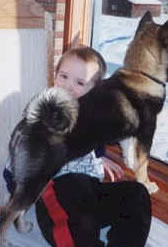 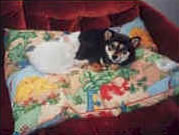 |
When raised with children (who respect pets), or cats, Shiba Inus do very well with them. Introducing an older Shiba to cats and children may be difficult. They are also very predictable dogs and have a very stable temperament, unlike many small breeds of dog (do not fear bite). NEVER leave a young child alone with ANY dog regardless of the breed you choose. Shiba Inus do possess many cat-like features. They are very clean and often groom themselves as a cat would. Their front paws are often used to bat toys and to clean their faces. Some Shibas climb as well as a cat. Perching up on a couch and looking out the window is a favorite Shiba passtime. House training is done naturally; the Shiba cannot stand to have any excrement nearby so learn quickly (5wks) where ‘outside’ is. They also naturally allocate one area of the yard as the bathroom. Young puppies will have an odd accident but are often completely reliable in the house by 5 months. Shiba Inus are very athletic and well muscled. They can climb steep hills and are at home on mountain slopes. The Shiba can even pull a small sled (it's best if you have two Shibas). They do enjoy hunting mice, birds and any other small game available. Our dogs recently caught a pigeon that happened to fly over the yard. They generally do not consume what they kill. Shibas are very brave dogs. Shibas also enjoy chewing, especially when they are young. Be careful what they chew because they may consume some of it, especially when they are puppies. |
Young Shiba Inu puppies hate a leash as much as a cat would. They will scream and the whole neighborhood will think they are being killed. The pup will grow out of this quickly and actually enjoy going for walks. Shibas generally dislike nail trimming so this should be a regular routine. We find using a dremmel tool much less stressful.
Shiba Inus are not noisy yippy dogs. Our dog’s bark when the doorbell rings, or someone, who should not be, is outside. Some say “Shiba’s don’t bark”. All or mine are quite capable of barking but only if there is a good reason. They are excellent watchdogs! The Shiba may not get along with other dogs, especially if the dog is the same sex. Socializing a puppy at an early age is very important.
The Shiba Inu only requires occasional brushing and weekly nail dremmeling. An occasional bath (one every 4 months) may be necessary but generally, they tend to keep themselves clean. They have very little ‘doggy odor’ in comparison to other breeds. People who tend to be allergic to dogs are often not allergic to Shibas.
The Shiba Inu makes a loyal and loving companion and if you love and respect him, he will do anything you want.
Back to top
![]()
Shibas are athletic little dogs whose catlike agility provides a good resistance to injury. In addition, their symmetrical proportions lessen their chances of the structural imbalances found in many other breeds.
CHIC Program Choose 'Shiba' and search to see the breeders who health test their breeding animals.
Shiba Inu Hereditary Issues:
Patellar Luxation: Prevalent in Shiba Inus. Requiring a $1500 operation per patella. The patella (kneecap) is or can be displaced from the normal position in the femoral trochlea. The severity ranges from grade one where the patella can be displaced manually but returns to normal when released to a grade four where the patella will be luxated all the time and the dog exhibits lameness and conformational abnormality (usually bowed legs). The only way to diagnose this disease if by examination by an experienced veterinarian. Vigorous manipulation of the kneecap by a veterinarian can also damage the kneecap, especially on a young puppy.
Hip Displasia: All purebred dogs and part-bred can inherit HD.
Hereditary Eye Defects: CERF Website. These are widespread among the canine population. No breed is free of eye problems. From 1991-’97, 553 Shibas were examined in the United States. Of those examined 454 dogs, or 82.1 percent were considered normal, while 99 dogs, or 17.90 percent were afflicted with one or more problems. Of those with problems, 14.52 percent were male and 20.51 percent were female. All dogs examined were under 5 years in age. A goinioscopy examination should be given to all Shibas to determine whether or not they have normal angles or not. Those who do not have a higher incidence of glaucoma.
Flea Allergies: In warm moist areas where fleas are never eradicated dogs sensitive to the insect suffer.
Dental Problems: Poor bites and missing teeth occur in every breed. When the problem becomes severe enough to interfere with the dog’s ability to eat it becomes a health problem. Small breeds tend to have more dental problems with weak jaws, poorly aligned teeth and early tooth loss. Up to 11 missing teeth has been reported as well as premature tooth loss. Quality and quantity of teeth should be checked.
Other Health Problems: Other problems have been reported but are not widespread. Heart murmurs, kidney failure, liver disease, double-jointed (popping) hocks, legg perthes disease, thyroid disease and other auto-immune disorders. There may also be a 'vicious syndrome' disorder similar to the condition found in Cocker Spaniels. The best way to purchase a Shiba is to seek a reputable breeder willing to guarantee puppies they produce. Until true genetic testing is available for the Shiba, no breeder can predict 100% a litter will be free of health issues.
Diet: You are what you eat - as the saying goes. When dogs are fed poor quality food they have little chance to achieve good health. High quality food is very expensive. It is worth researching what will be fed to your puppy the first important weeks of its life. Research dog food options on the internet and learn which foods to avoid. The list is always evolving.
Back to top
![]()
After much research you have decided a Shiba Inu is for you. Now your search for a Breeder begins.
BREEDER PRODUCING HIGH NUMBERS: Quantity and Quality are often far apart. This information is available to the public from The Canadian Kennel Club. Keep in mind Shibas usually have 2-4 puppies per litter. In most cases producing more than 20 puppies per year is excessive.
LITTERS/PUPPIES PER YEAR: How many litters do you have a year? This should be one litter per female per year. The majority of reputable breeders have an average of three to five litters per year). Also note whether the breeder keeps their own puppies to show or do they sell everything they produce. Do they breed old females (over six)?
PET STORE/PUPPY MILL? To find Shiba breeders in your area search the web. There are various magazines listing breeders such as Dogs USA or Dogs in Canada Magazine (these are also available online). Advertising in the magazines or on the web does not indicate reputability. The larger ad (full page) may in some cases indicate the opposite. Be very careful. Each breeder should be visited and evaluated by yourself or someone you trust.
DOES THE BREEDER WANT YOU TO BREED ALSO? Is the breeder trying to place a dog with you with a stipulation to continue allowing them to breed using your pet? A breeder who requires you relinquish your pet to be bred is basically making money at your expense. Does the breeder intend to keep a puppy from your dog or just sell everything born? Another sign this is being proposed to make money for the breeder at your inconvenience. Pet dogs should be only pets and breeders should keep the dogs they want to breed on their own property at their own expense and risk.
VISIT THE BREEDER: Always view a puppy where he/she was born. NEVER agree to meet the breeder at a different location. The breeder should allow you to see ALL of the dogs and complete facilities on the premises. You should also be able to see the puppy’s Dam and possibly the Sire. If the Sire is not available, a reputable breeder will have pictures and paperwork for the Sire. The dogs you view should be well cared for.. Puppies should be clean energetic and free of disease. If you see breeding dogs of unacceptable colors or long-coated Shibas or a high volume of unacceptable colored puppies this often indicates 'puppy mill'. A
LISTEN TO YOUR INSTINCTS: Puppies of all ages all over the house indicate a mill. If something seems 'off' it probably is. If the dog numbers you see feel overwhelming, there probably are too many. If the dogs look uncared for - they most likely are ignored most of the time.
INDOOR vs OUTDOOR? In Alberta we have extremely cold periods throughout the winter. Small dogs should not be housed outdoors under these conditions. Our dogs are indoors and run outside regularly. Puppies should also be raised indoors with house noises – not outside. The breeder should be available to take the puppies in and out regularly as the new owner would.
IN-BREEDING: Ask to see a five or more generation pedigree for the puppies available. Ask for the inbreeding co-efficient (COI) for your potential puppy. A breeder may defend the practice of in-line breeding. Also check with a veterinarian. They often see the outcome and will have opinions. Or buy the book Canine Genetics – Padgett, DVM
BREED FOCUS: If you find a kennel with a number of different breeds attempting to appeal to all markets for financial gain. Reputable breeders focus on and choose one breed.
REFERENCES: Do you have references? Shiba owners or Veterinarians? A long relationship with a veterinarian?
SHOWING SHIBAS: Do you show your dogs? (Obedience or Conformation). (Note: this does not guarantee good health). How the Ch. was obtained is also important. In some Provinces very few Shibas are shown. Often one breeder will take three Shibas and make Champions. Often it is difficult to know whether a Shiba is a worthy or unworthy Champion. Judging practices at dog’s shows can be very much like figure skating. Often there is no consistency throughout a three day show with three different judges. A knowledgeable breeder will evaluate structure/pedigrees and health to make educated breeding decisions (not focus on the current show results).
HEALTH TESTING/OFA: Have you submitted your health testing information to the Orthopedic Foundation and can I have the registered names of the puppy's sire and dam? You can verify Hillsdale Shibas by clicking this link OFA database.
REGISTRATIONS: View Registration records? Registration papers from a recognized registry (Canadian Kennel Club or American Kennel Club ONLY)should be provided at no extra expense to the buyer. Other fake registries exist – beware. Bogus registries include: Continental Kennel Club, United Kennel Club, American Pet Registry etc. These clubs will register any crossbreed you care to invent.
PURPOSE AND GOALS: Does the Shiba breeder seem to be moving ahead – or breeding elderly dogs repeatedly? Can the breeder demonstrate they are moving ahead with their breeding program? Reputable breeders breed with the intention of keeping their next show/breeding hopeful. Carefully deciding whom to breed to whom. A breeder who simply breeds to produce pets, keeping no puppy from their effort is only doing so for financial gain.
CONTRACT STIPULATION LEADING TO NO WARRANTY: Some breeders have a 48-hour clause requiring you to take your puppy to a veterinarian (or the guarantee becomes null and void). This is another very questionable practice. Our puppies visit our veterinarian at 8 weeks of age and you do NOT have to go to a veterinarian until four weeks later, when the puppy has a second puppy vaccination. We are first to know if the puppy has health issues. If a disease process begins after you take your puppy home, the incubation time will determine 'Where' the disease was contracted. Taking puppies to a veterinarian unnecessarily is not recommended (your puppy may contract a virus).
GUARANTEE/Contract? This guarantee should be valid for five years as genetic defects arise most commonly between three and five years. A breeder who demands the return of your dog to fulfill a contract is avoiding their contractual obligation.
MICROCHIP OR TATTOO: Which is your breeder using? Tattoo's are difficult(often impossible) to read and Microchips scan easily. Contact local shelters and veterinarians and research the recovery rate of dogs with either identification method. Tattoos are $10 when compared with a microchip $50. We only Microchip. The tattoo often does enable the breeder to dissolve their association with the puppies they produce within 5 yrs – when the tattoo becomes illegible.
FUTURE CONTACT: Breeders who care about the puppies produced hope to be available to answer questions throughout your dog’s life.
RESCUE: Also ask breeders if they Rescue or have ever re-homed a Shiba Inu who was not originally from their kennel. Rescuing can be inconvenient and time-consuming as well as very rewarding. When the Shiba has no breeder associated I will always help find a nice new home. Will the breeder take their own puppies back? Some will not, so you might want to ask. A reputable breeder will take their puppies back.
Back to top
![]()
Here are some Shiba Inu pictures with interesting graphic effects and various other types of artwork.
